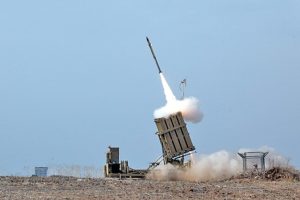Israel-Hamas Ceasefire Is Only a Temporary Solution

By Israel Defense Forces and Nehemiya Gershuni-Aylho נחמיה גרשוני-איילהו (see also https://he.wikipedia.org/wiki/%D7%A7%D7%95%D7%91%D7%A5:Flickr-IDF-IronDome-in-action001.jpg ) – https://www.flickr.com/photos/idfonline/8194572552/, CC BY-SA 3.0, https://commons.wikimedia.org/w/index.php?curid=34360609
Like clockwork, Hamas announced another ceasefire with Israel last week, de-escalating tensions after weeks of violence along the Gaza border. It is a positive development each time the fighting stops. Yet, the ceasefire agreement is merely the temporary conclusion to another wave of Palestinian violence that is bound to repeat itself – unless the international community shifts its approach.
Since Aug. 6, Palestinian terrorists had been launching explosive balloons into Israel, scorching farmland, and threatening the lives of civilians. As has become its standard response to this aggression, Israel retaliated with airstrikes and tank fire on Hamas infrastructure, closed Gaza’s fishing zone, and halted the transfer of goods into Gaza, excluding those necessary for humanitarian aid.
With this latest ceasefire, Israel announced that it would again allow fishing in a 15-nautical miles stretch off Gaza’s coast, as well as the flow of goods back into the Strip. According to reports, Israel also agreed to increase the fuel supply to Gaza’s power plant, and Qatar will provide Hamas with roughly $27 million in aid.
It is unclear how Hamas will spend the money, but it claims to have used Qatar’s previous gifts to support impoverished families, pay civil servants’ salaries, and purchase fuel. However, Gaza’s economic condition has not improved, and Hamas repeatedly resorts to violence to extract more cash from the Qataris.
As an added twist to the latest violence, coronavirus concerns in Gaza may have played a vital role in the latest ceasefire agreement. This past weekend, officials in the Gaza Strip became worried that the rising number of coronavirus cases could spiral out of control. Authorities issued a five-day lockdown for the entire Gaza Strip after a spike in cases. A full outbreak of coronavirus could be catastrophic for Gaza’s failing economic and health infrastructure.
However, the coronavirus is undoubtedly not the only factor leading to another ceasefire. While Hamas remains Israel’s bitter adversary, neither side wants to fight another major war as they did in 2009, 2012, and 2014. Instead, there have been many short, violent cross-border flareups in recent years, with each ending in a ceasefire almost identical to the one they just arranged.
Israel believes that a full-scale invasion of Gaza would leave it with the responsibility of overseeing the territory. Israel has signaled it will respond to aggression when necessary, but its focus is on its northern border. Any broad operation in Gaza would distract and divert resources away from Hezbollah and Iran’s efforts to spread advanced precision weapon systems in Syria and Lebanon.
Israel’s improved technological capabilities allow it to respond to low-level violence without significantly diverting much attention from the north. Israel’s Iron Dome short-range missile defense system has proved effective at intercepting Gazan rockets. In August, Israel deployed a new tactical laser for the first time to shoot down the explosive balloons coming from Gaza.
Another war with Israel would also highlight Hamas’s ineffective rule by bringing an unnecessary loss of life and destruction to Gaza’s collapsing infrastructure. Even before coronavirus, Hamas proved itself incapable of providing effective governance. Water and electrical shortages have long plagued Gaza. Protests demanding even meager economic reforms have faced brutal crackdowns from Hamas, which fears any challenge to their precarious rule over the Gaza Strip.
Yet, there is always the potential for intentional or accidental escalation that leads to another war. Hamas or the even more aggressive Palestinian Islamic Jihad could easily bite off more than they can chew as they test Israel’s restraint. Israel has made clear that it will not tolerate attacks and will respond with greater force if necessary.
Instead of rewarding Hamas for its mismanagement and terrorism against Israel with millions of dollars, the international community should restructure how it provides aid to the Palestinians. Reform options include the Trump peace plan, which Palestinian leadership in Gaza and the West Bank have vehemently rejected, or moving the United Nations Relief and Works Agency for Palestine Refugees in the Near East’s responsibilities to the United Nations High Commissioner for Refugees. Either way, the status quo is not sustainable in the long term. With each round of violence, Gaza – and the chances Qatari cash can stave off another war – deteriorates further.
Indeed, the latest ceasefire is a positive step. Gazans will be able to fish again, and have more access to electricity, and Qatari cash. On the other side of the border, Israelis will have a break from explosive devices setting their property ablaze. While the status quo makes a significant war unlikely, it also, unfortunately, means the next sequence of cross-border attacks is just around the corner.
Ari Cicurel is a senior policy analyst at the Jewish Institute for National Security of America’s Gemunder Center for Defense and Strategy.
Originally published in Israel Hayom